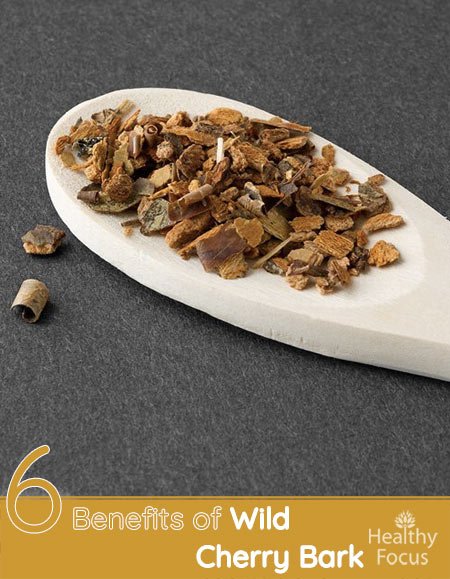Last Updated on January 27, 2019 by Marc Seward
What is Wild Cherry Bark?
Most people associate cherry trees with their beautiful blossom and the delicious fruit that they bear. Who does not love the taste of cherries whether you eat them fresh or use them in sweet pies and jam.
However, most people are far less familiar with another of the tree’s many treasures – its bark. Wild cherry bark has a variety of medicinal uses that date long back in history. It is especially well-known for its ability to treat soughs and other respiratory issues but can also help heal poor digestion and may also act as a mild sedative.
The botanical name for wild cherry is Prunus serotina and it belongs it the Rosaceae family. Other common names for the tree are Chokecherry, Wild Black Cherry, Virginia Prune, Cabana Cherry, Black Choke and Rum Cherry.
Description
The Cherry tree is originally native to Asia but was then imported into Europe and parts of North America. However, the Wild cherry tree is thought to be native to North America and it grows throughout many parts of the continent from Canada through the Carolinas to Florida.
The wild cherry tree is a relatively large, deciduous plant that can reach a hundred feet in height. It has rough brownish-red bark and beautiful dark oval leaves. During the spring, the tree bears delicate, little white flowers which are followed by a purple or red fruit that ripens during the late summer or early in the fall.
History
The wild cherry tree has long been used for food and drink and used for medicinal purposes. The early colonists to the United States used wild cherry bark as an ingredient in cough preparations. They may well have leaned about its medicinal properties from Native Americans who used the bark not only to treat coughs but also for diarrhea and for lung complaints.
The Cherokees utilized the bark for pain relief during labor while the Mohegans saw it as a remedy for various illnesses including dysentery.
In 1820, wild cherry bark got listed officially in the United States Pharmacopoeia as an antitussive and sedative.
Health Benefits of Wild Cherry Bark
The reason that wild cherry bark has therapeutic value owes a great deal to its constituents. These include tannins, p-coumaric acid, kaempferol, quercetin, acetylcholine, benzaldehyde and caffeic acid.
Wild cherry bark also possesses various minerals such as calcium, potassium, magnesium, phosphorus, iron and zinc.
1) For Respiratory Conditions
Wild cherry bark has traditionally been used to treat coughs and other respiratory complaints. It has excellent natural expectorant qualities meaning that the bark can help to loosen up phlegm or mucus from the respiratory system.
Wild cherry bark tea or syrups can help you expel this phlegm or mucus and clear out the bronchial tubes allowing you to breathe far more comfortably.
As well as coughs and colds, people have traditionally used wild cherry bark throughout the years to treat a wide variety of other respiratory conditions. It has been used to treat bronchitis, tuberculosis, asthma, catarrh and scrofula.
As well as expectorant properties, wild cherry bark has antitussive qualities and the ability to suppress coughing very effectively and quickly. People with chronic coughs and nervous coughs may well benefit from its use.
Because of these excellent natural abilities, wild cherry bark is often used as an ingredient in commercial cough syrups, lozenges and drops.
2) As a Sedative
One of the other major uses of wild cherry bark is as a sedative. Its effects are considered to be mild but for anybody feeling slightly on edge, it may be an excellent natural remedy to calm the nerves.
It might help calm down the nerves and even treat some of the the symptoms of anxiety like indigestion and sleeplessness. According to traditional use, it can help calm down the nervous system and may help slow down the heart beat. There are even people who claim it can reduce high blood pressure but there is no scientific evidence for these claims.
If you would like to try a safe and natural remedy for feelings of stress or mild anxiety, the best way to use wild cherry bark is in tea form. Like many herbal teas, it is an excellent option to calm the nerves without worrying about the side effects and dependence associated with strong pharmaceutical sedatives.
The relaxing nature of wild cherry bark tea can also help ease muscular tensions, cramps and headaches. According to proponents and some herbal practitioners, it makes an excellent soothing tea for women suffering from painful menstruation.
3) For The Digestive System
Apart from its most popular uses, wild cherry tree bark can confer various other health benefits. Wild cherry bark tea is commonly use by herbalists to improve digestive problems. It is sometimes recommended to help treat common but often troublesome complaints like diarrhea, bloating, gas and indigestion.
Drinking a soothing cup of wild cherry bark tea immediately after eating a heavy is an excellent way to ensure that your digestive system can cope with the load. This can help reduce the risk of indigestion while its astringent properties can help to relieve bouts of diarrhea and colitis.
4) Worms and Parasites
Wild cherry bark has traditionally been used to help treat people infected by various worms and parasites. The bark is reputed to be antiviral, antibacterial and anthelmintic in nature meaning that it has the ability to destroy parasitic worms. However there have not been any scientific studies to confirm its traditional use.
5) Cancer
I have come across plenty of claims that cherry bark tea might help protect against various types of cancer. However, there is little to no scientific evidence to date to demonstrate that that this is true.
There has been one piece of research linking wild cheery bark extract to cancer. Research published back in 2006 found that the extract helped to suppress the growth and proliferation of colorectal cancer cells.
Certainly, far more research needs to take place before anybody can start recommending wild cherry bark tea as a treatment for any serious illnesses such as cancer.
6) Topical Uses
As well as being used for internal use, it is possible to apply wild cherry bark topically. It can be used to help treat various chronic skin conditions like psoriasis, eczema and acne and to soothe rashes caused by irritation. It can also be used in the form of an eyewash to help reduce swelling and puffiness in the eyes.
How to Use Wild Cherry Bark
Wild cherry bark is available in various forms including extracts, syrup, capsules, creams and tinctures. It is also commonly drunk in the form of a tea.
Wild Cherry Bark Tea
Wild cherry bark tea is very easy to make by following these simple instructions:
- Add 2 teaspoons of dried cherry tree bark to around 2 cups full of water.
- Put the water in a pot, bring to the boil and then reduce the heat to a simmer.
- Let the mixture simmer for ten minutes or so.
- Cool, strain and add honey and lemon if desired.
Side Effects
- Wild cherry bark is generally regarded as safe to take as long as you do not overdo your dose.
- Make sure that you read the instructions before using any supplementary forms.
- In tea form, you are not recommended to drink more than 3 cups a day.
- Wild cherry bark contains hydrocyanic acid which may be dangerous if taken long term on in very high doses.
- Pregnant women, nursing mothers and children under the age of two should avoid using wild cherry bark.

Leave a Reply
You must be logged in to post a comment.